
MAY CONTAIN NUTS

Search Shorpy
SHORPY ART

Framed or unframed, desk size to sofa size, printed by us in Arizona and Alabama since 2007. Explore now.
Join and Share
Ad-Free Shorpy
Shorpy is funded by you. Patreon contributors get an ad-free experience.
Learn more.

Recent comments
- Alas, hidden from view
- Exclusive pump
- Details, Details
- What's that building to the left of the tower?
- Coal Barges
- Bromo-Seltzer
- Inner harbor
- The Basin
- What a headache!
- Giant stepladder?
- Baldwin 62303
- Baldwin VO-1000
- Cold
- No expense spared
- Tough Guys
- Lost in Toyland
- And without gloves
- If I were a blindfolded time traveler
- Smoke Consumer Also Cooks
- Oh that stove!
- Possibly still there?
- What?!?
- $100 Reward
- Freeze Frame
- Texas Flyer wanted
- Just a Year Too Soon
- WWII -- Replacing men with women at the railroad crossing.
- Yes, Icing
- You kids drive me nuts!
- NOT An Easy Job
Member Photos
The Shorpy
Print Emporium
Print Emporium
Search Shorpy
Search results -- 30 results per page
- High Gear: 1926
- ... the company expired in 1930. 5x7 inch glass negative by Christopher Helin. View full size.
No Tread On Me The question is whether this ... Posted by Dave - 09/30/2014 - 2:15pm -
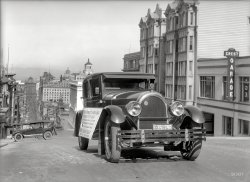
- The Damner: 1920
- ... stunt is preserved in this 5x7 glass negative by Christopher Helin. View full size.
Ohio? Not sure how much help it would be ... Posted by Dave - 11/22/2014 - 7:48pm -
![The Damner: 1920 The Bay Area in 1920. "Dodge auto on boardwalk. 'The Damner' on Miller Tires Coast-to-Coast." All we know about what seems to have been a promotional stunt is preserved in this 5x7 glass negative by Christopher Helin. View full size.
Ohio?Not sure how much help it would be tracking down what the heck is going on here, but that's an Ohio license plate.
Ocean BeachI'm going with Ocean Beach. There's surf, so it can't be the bay side. And there's a hint of Marin visible through the fog.
New York to FriscoThat's what it says in the rear window.
Miller TiresI did a such for Miller Tires and found they were made in Akron, Ohio. They were the second rubber company to get started in Akron, following B. F. Goodrich.
J. Pfeiffer, J. Gether & J. Lamparter started a rubber company in 1892 but were broke in a few years. 1898 they had taken on new partners, W. Pfeiffer and Harvey Miler and in 1906 the new company was named Miller Rubber Company. They started making tires several later.
Yellowstone "Zoo Windshield"These window stickers were popular National Park souvenirs.
Ocean Beach Boardwalk?Was there ever wooden jetty at Ocean Beach? or a boardwalk?
[Yep. Here circa 1915. -tterrace]
Dodge yearThis car predates 1920. Note the headlights are in back of the line of the radiator. The headlights were moved forward of the radiator line circa 1917.
America FirstSomeone out there must know about these.
Life Saving PierThis is indeed a view of Ocean Beach, San Francisco. The auto is parked on the rescue boat launching ramp once located at the foot of Fulton Street. The rescue crews of the Golden Gate Park Life Saving Station used it for hauling their horse-drawn boat carts across the dunes.
The pier that tterrace referenced is visible at the extreme right of this view. It wasn't a boardwalk, though, but rather a water intake pier for the nearby Lurline Salt Water Pumping Plant that sucked seawater out of the Pacific and pumped it to various saltwater bathing establishments downtown.
At far left is the "drill mast" used by the Life Savers from the Golden Gate Station. Literally a mockup of a sailing ship's mast, the crewmen used it as a target when they practiced firing shore-to-ship lifelines.
Junior Road TripThis from the Automobile and Sports section of the October 24, 1920 issue of the Los Angeles Times:
(The Gallery, Cars, Trucks, Buses, Chris Helin, Swimming)](https://www.shorpy.com/files/images/SHORPY-137-01A.thumbnail.jpg)
- - Need Lumber Quick?
- ... Lumber Co., Fifth and Brannan." 5x7 glass negative by Christopher Helin. View full size.
The Clock At this time clocks were still ... Posted by Dave - 11/14/2014 - 10:29am -
![- Need Lumber Quick? San Francisco in 1920. "Federal truck -- Van Arsdale-Harris Lumber Co., Fifth and Brannan." 5x7 glass negative by Christopher Helin. View full size.
The ClockAt this time clocks were still mechanical because you couldn't count on the accuracy of the 60 cycle frequency of AC to keep electric clocks accurate. Instead, they either used batteries or AC to run a motor that would wind the clock when the running weight got to the bottom (think grandfather clocks).
Freight car style turnbuckle trussesIn my neck of the woods they were referred to as hog rods. They were frequently used in old wood-framed buildings as primary roof supports. I believe they were employed in Mississippi/Missouri River steamboats before railroad freight cars. They were oriented oppositely to those in freight cars and prevented the boat's hulls from hogging, i.e., bending upward in the middle. See The Western Rivers Steamboat Cyclopoedium by Alan L. Bates.
B-R-O-T-H-E-?PLEASE! Anybody know what comes after the E?
[So to speak. - Dave]
After so many yearswhy the L do you want to know now?
Sometimes it's better not to knowA 1912 ad in the "San Francisco Call" shows "White Brothers," a lumber company, at Fifth and Brannan.
Disappointed by reality, once again.
Front brakes are dangerous!So this Federal truck has none. We also like the freight car style turnbuckle trusses under the frame, certainly overkill for the wimpy lumber load we see here.
Lumber SupportThose turnbuckles are for lumber support. Helps keep the truck from having back problems.
SF Tennis ClubIs the present occupant. The high pressure hydrant on the other side of Brannan St was likely moved when they widened the street.
If an L then good wood is good !Perhaps not worth posting but I laughed at my own joke. Sorry!
Under the EavesA very interesting location to place a pendulum clock. You can see the hinges where It could be opened up and wound or adjusted. I wonder if the case still contained the original works when the photo was taken, or if the clock had been swapped out for one powered by electricity.
I hope the driver tightens down the rope before beginning his delivery as it does not seem very taut.
(The Gallery, Cars, Trucks, Buses, Chris Helin, San Francisco)](https://www.shorpy.com/files/images/SHORPY-122-01.thumbnail.jpg)
- Nash Rumbler: 1926
- ... seat roadster at Phelan mansion." 5x7 glass negative by Christopher Helin. View full size.
That's 2150 Washington Street
... Posted by Dave - 11/07/2016 - 2:34pm -
![Nash Rumbler: 1926 San Francisco circa 1926. "Nash Special Six rumble seat roadster at Phelan mansion." 5x7 glass negative by Christopher Helin. View full size.
That's 2150 Washington Street
QuestionHas does one even climb into that rumble seat? Get a good running jump?
[Cars with rumble seats had steps provided at various places on the curb side of the vehicle. -tterrace]
NiceI love the car. Big wide running boards, and cool rumble seat. It's also nice to see the building has been preserved with a nice cover added to the upper open area.
Mother-in-law's lament"If my daughter had married that nice Bob Gunderson, I'd be riding in a Cadillac now!"
Out-of-it FeelingIt's good for kids together but you definitely are not part of the adult conversation back there, having ridden in one of those seats.
Will never understandhow the fairer sex could ever get into one of these things with grace and aplomb.
[Grace would be riding up front with Aplomb. - Dave]
Rumble alonePut Mom in the back. So I can't hear her back-seat driving.
(The Gallery, Chris Helin, San Francisco)](https://www.shorpy.com/files/images/SHORPY-1057.thumbnail.jpg)
- When Fancy Met Schmancy: 1927
- ... keeping chickens or children. 5x7 glass inch negative by Christopher Helin. View full size.
Quite some house Does it still exist?
... Posted by Dave - 02/12/2016 - 10:38am -
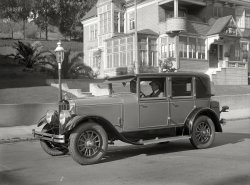
- The Happy Wanderer: 1918
- ... Shorpy Index of Ill-Fated Phaetons. 5x7 glass negative by Christopher Helin. View full size.
Interesting headlight lenses I wonder what ... Posted by Dave - 03/11/2016 - 10:56am -
![The Happy Wanderer: 1918 "Marmon touring car, San Francisco, 1918." Latest entry in the Shorpy Index of Ill-Fated Phaetons. 5x7 glass negative by Christopher Helin. View full size.
Interesting headlight lensesI wonder what purpose was served by the designs in the glass.
[They're Warner headlight lenses. Click to enlarge. -tterrace]
Warner DangerThe Warner-Lenz may have been "resistless", but judging by the list of car makers who adopted it, it was the Heisman Trophy of the auto industry!
Re: Warner LensesI believe there may be just the tiniest bit of exaggeration in the maker's claims.
New Car, Used (?) TiresCurious - the car appears to be new - dealer plates, clean undercarriage, shiny paint, with tires totally scraped and scuffed. Were new tires optional?
Amazing finishAlways amazed and the amazing paint finish and body panel fit on these early cars.
Maypop tiresThose tires look old and have messed up sidewalls. Why are they on this new-looking dealer car?
tterrace's advert for the headlight lenses lists the car companies carrying them as standard equipment. It is, in retrospect, not a promising list.
White Sidewall TiresThis is the first time I have noticed the tires had white sidewalls on both sides. Today, white sidewalls are only on one side. When did that change and why?
Headlight lensesI have a 1914 Hudson with Warner Lenz headlight lenses.
I just like the looks of them.
One of America’s bestI read a magazine article several years ago about the five greatest cars ever produced in America, and the 1931 Marmon was one of them (I think it was Brock Yates who wrote the article). They consistently made excellent automobiles until the Great Depression forced them to go out of business (just like Duesenberg and Stutz). Anyway, that stuck in my mind because I had never heard of Marmon before I read that article.
Marmon BusinessMarmon did get back into the transportation business, they were making trackless trolley coaches for Philadelphia, Pennsylvania's Rte. 66 on Frankford Ave. in 1955. Long ago, I think that they also made side cars for motorcycles.
(The Gallery, Cars, Trucks, Buses, Chris Helin, San Francisco)](https://www.shorpy.com/files/images/SHORPY-920.thumbnail.jpg)
- Franklin Gothic: 1919
- ... Catalog of Quirky Conveyances. 5x7 glass negative by Christopher Helin. View full size.
Replica Residence The noble home in the ... Posted by Dave - 02/16/2016 - 6:29pm -
![Franklin Gothic: 1919 San Francisco circa 1919. "Franklin Brougham." A car with an air-cooled engine and unusual veed windshield. Latest entry in the Shorpy Catalog of Quirky Conveyances. 5x7 glass negative by Christopher Helin. View full size.
Replica ResidenceThe noble home in the background is at 3800 Washington Street in San Francisco. It was built in 1904 as an homage/knockoff of the Petit Trianon on the grounds of the Palace of Versailles in France.
According to zillow.com, there's currently an offer on it for a cool $18 million (give or take a few sous).
Sugar Daddy's House[An impressive edifice, but it's obviously not Spreckels Mansion. - Dave]
Duh! My bad. I spent 30+ minutes on Street View and Images trying to pin it down w/o success.
Unusual in many waysProbably the most unusual thing about the early Franklins is they used a Wooden frame up to about 1928.
[Many, if not most, autos of the era used wooden frames. - Dave]
Thanks for the Memories!A friend of my dad's, Mr. Bill Gewand of Buffalo, New York, had a copy of this car back in the late 1950s. As the old saw goes, he found it in a barn where the farmer was using it as a chicken coupe, although in this case it was true. It took a lot of TLC, but he got the car looking almost as good as the one in this photo and running like a dream. Your picture brought back happy memories, thank you very much.
["Chicken coupe;" haha, very good. -tterrace]
Thug Mansion3800 Washington was also occupied by a squatter for months recently.
YIPPEE!!!!!!My styling favorite car EVER! Besides a lot of unusual standard features like wooden frame and air-cooled engine, the V or "veed" windshield was a Franklin trait up through the mid-20's; available on their closed cars. It doesn't show well in this photo but if you could see a photo of this dream car from the front, it looks like a spaceship. Too cool; thank you, thank you, thank you!
Design Of The FutureAerodynamic Windpusher.
Wooden It Be NiceThough the Franklin was known for having a wooden chassis, few, if any, major auto manufacturers used them.
[Not so, as owners of brass-era and later cars will attest. Maurice Hendry, in "Cadillac: Standard of the World," recalls an anecdote in which an ash-framed Cadillac chassis proved more resistant to being twisted apart than a steel frame. Below, an excerpt from "Making and Selling Cars: Innovation and Change in the U.S. Automotive Industry." - Dave]
Though I am in no position to argue with a man like Mr. Hendry, he is wrong. Every Model T ford ever built had a steel frame. So did every Dodge, every Durant product, every Maxwell, every Sudebaker (after they went to gasoline powered cars). Pierce, Pope, Stanley, Thomas, Stoddard Dayton, Alco, Locomobile, White, just to name a very few used steel frames. As to Mr. Hendry's assertion that Cadillac used a wooden frame, here is an excerpt from The History of Cadillac.
"The 1903 chassis had angle steel frame with two half-elliptic springs front and rear with straight, tubular front axle. The steering wheel was located on the right-hand side with the controls to the right and using adjustable rack and pinion steering gear. The single tube tires were mounted on 56 cm wood wheels with 12 spokes (14 on the prototype)."
Every Cadillac, ever built, had a steel frame
Wood it, or notCould be that the wood "frame" referred to in some places is the wood that "framed" the body of the cars, and not constituted the chassis' structure. Fisher Body ( read GM) didn't cease wooden framed construction until the mid 1930s. Custom built cars, and low production ones lasted even longer.
Re Wooden It Be NiceIs it possible that the word "frame" is being used in different ways? Certainly the Model T and Model A had a great deal of wood in the "frame" that supported the body panels. This was true of many other cars, and is still true of Morgans (the last time I looked). While I don't know of any that used wood for the "chassis" (another ambiguous word) that supports the axles, driveshaft, etc, I wouldn't be terribly surprised if some early ones did so. Here's a link to diagrams of the "body frame" wood for Ts and As:
http://fordwood.com/
(The Gallery, Cars, Trucks, Buses, Chris Helin, San Francisco)](https://www.shorpy.com/files/images/SHORPY-896.thumbnail.jpg)
- Milady's Marmon: 1919
- ... Square between Geary & Post." 5x7 glass negative by Christopher Helin. View full size.
Another example The lady's muffled appearance ... Posted by Dave - 05/08/2017 - 8:17pm -
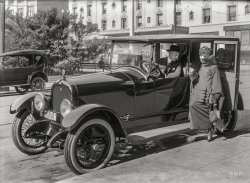
- Ready to Roamer: 1921
- ... the Shorpy Chart of Chilly Chariots. 5x7 glass negative by Christopher Helin. View full size.
Article on Barley motors A very long ... Posted by Dave - 06/24/2017 - 8:49am -
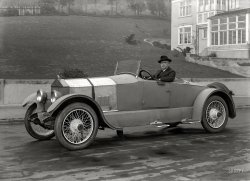
- A Couple of Cads: 1919
- ... a veritable wonderland of chalk art. 5x7 glass negative by Christopher Helin. View full size.
Yes, Good Riders? That appears to be the ... Posted by Dave - 12/11/2015 - 10:21pm -
![A Couple of Cads: 1919 San Francisco circa 1919. "Cadillac touring car and sedan." Touring a veritable wonderland of chalk art. 5x7 glass negative by Christopher Helin. View full size.
Yes, Good Riders?That appears to be the message displayed within the diamond-shaped decal on the passenger side windshield.
What, pray tell, would be the meaning of that display?
[It's "Yes Good Roads," a slogan in support of a 1919 California ballot proposition for a $40,000,000 bond issue to fund state highway construction. It passed. -tterrace]
Board FenceThis is the definitive modelbuilder's reference for a board fence. They were common within my memory, and my wife remembers them too. You still see a few in old western PA towns.
Note that some kid dragged chalk the length of the fence.
Reproducing the faded "HORP" sign on the fence between the cars would be a modeling challenge.
SlummingNot the most Cadillacky of neighborhoods.
LocationAre you sure this isn't Oakland? Those two beauties look like they're just about to try to merge, the hard way.
StandoutsStrange to see these two elegant, up-scale vehicles placed in a very humble neighborhood (with its ubiquitous chalk markings) as opposed to the previous auto portraits "uptown".
GlossyI always admired the top coat finish on these cars. A mirror finish not displayed these days.
New cars but old tiresCan't help but notice how worn the tires are on these apparently new vehicles. The front ones on the car on the right don't even match. I don't think that "optional" bumper on the coupe is really going to stop much. It's interesting to note that even on high end cars like Cadillacs there are rows of rivets along the edges of the hood. Auto designers today go out of their way to hide fasteners to the point it is sometimes difficult to figure out how to remove a piece for repair.
Twins?Are the two gents in the touring car twins?
CadillacsThe car on the left was previously shown here. This is one of the two touring cars models Cadillac sold in 1919. Both models were on the same 125 inch wheelbase, but one had jump seats and sat seven instead of four passengers. Both were priced at $2,805, and the standard colors were Cadillac Blue with black trim. The dealer license plate indicates the car was being sold by Don Lee Cadillac shown here.
The second cars looks like a Convertible Victoria. The side window glass and center door post could be removed to create a semi-open car. This car was also on the 125 inch wheelbase and cost $3,205.
(The Gallery, Cars, Trucks, Buses, Chris Helin, San Francisco)](https://www.shorpy.com/files/images/SHORPY-825.thumbnail.jpg)
- Monster Truck: 1918
- ... version of the Cookie Monster. 5x7 glass negative by Christopher Helin. View full size.
Okay, I give up! A partly squashed giant ... Posted by Dave - 03/25/2016 - 10:12am -
![Monster Truck: 1918 San Francisco circa 1918. "White 5-ton motor truck loaded with Sperry Flour bound for Los Angeles." Guarded by what looks to be a prototype version of the Cookie Monster. 5x7 glass negative by Christopher Helin. View full size.
Okay, I give up!A partly squashed giant mutant lemur? An old bear rug ravaged by acid rain? A besotted sloth fallen from a tree? The world's most hideous fur coat?
Funny how absence of natural visual context can render what is probably a most pedestrian item mystifying.
Sasquatch SuitI'd want a yeti-skin driving coat if I had to pilot an open cab truck like that down CA 1 or US 101. I imagine they took the old Spanish route. I think the coastal highway was a depression-era WPA project.
The caption doesn't say what time of year they started the trek, and it's hard to tell by clothing in San Francisco.
"The coldest winter I ever spent was a summer in San Francisco." (attributed to Samuel Clemens)
Dump TruckIt's an early dump truck, complete with remote tailgate lock. Unlike modern dump trucks, the bed trunnion is well forward, partially balancing the load, thus reducing the weight that the hoist needs to lift. The big chain is apparently part of the hoist, acting on the bottom of the triangular frame just in front of the rear axle.
Carbide headlights, but the light by the windshield appears to be kerosene. I recently saw carbide headlights in operation. They are surprisingly bright, with a near-white light.
Appears the driver has thrown his insulated coveralls on top until time to depart.
Wonderful picture.
No run-of-the-mill vehicleI'm sure a rig like that cost a lot of dough. Thanks for enriching our lives once again.
[You've got some crust making remarks like that. -tterrace]
We didn't make good timeI'm thinking at best this vehicle would average about 12 mph loaded like that and travelling on what was likely a very winding route with many grades, completing the trek in about 40 hours...plus time lost for maintenance stops, filling the radiator and whatever other nonsense trucks in those early days required. Not a fun or very efficient trip.
Heavier DutyThe truck may be heavy duty, but it looks like the operator needs to be even heavier duty. There's barely the bare necessities, let alone creature comforts.
Keep it flowingSolid rubber tires and lack of springs must of made it a very bumpy ride. The ride was probably measured in bathroom breaks rather than MPG.
Snappy!Notice the great shoe-shines all around! Also, love the boy with the screw-on skates - I had those. Now, where is my skate-key??
Those are the BrakesNote the lack of brakes on the front axle. Driving down a San Francisco hill with a 5-ton load might be a hairy experience !
No seat belts and no doors - because jumping overboard might be the most sensible thing to do if she runs away on a hill !
Yep, two wheel brakes, no windshield, solid rubber tires......that trip to LA is going to be a memorable adventure, sheerling coverall or not.
Re: "We didn't make good time"Although these trucks seem slow by today's standards, they were much more efficient than what was used previously to haul heavy loads - the horse and cart.
"The American Contractor," a trade publication, published in their October 23, 1920 issue, on page 21, a comparison of what the truck was doing compared to a horse. Mr. Olaf Nelson, the man mentioned in the article, owned a quarry, and he was using two 5-ton White trucks with trailers to haul gravel for a road construction project. The trucks were delivered to him in July and August 1919.
"A team of horses, Mr. Nelson had estimated, could accomplish the maximum haul of 16 miles, making one round trip with a wagon containing two cubic yards of gravel, in an 8-hour day. One truck on the other hand, could make six round trips daily and carry five cubic yards of gravel each time. One truck alone would thus do the work of 15 horses; with a trailer equipment, the truck could do the work of 20 horses."
"Random glances at the record book showed each truck to have hauled an average of 45 tons a day over one seven-day period. Over another period of six days, hauling various distances, one truck hauled a total of 317 tons of gravel. The weight of one cubic yard of gravel is 2,800 pounds.
"'I regard my two White trucks with their trailer equipment, as better than 70 head of horses,' remarked Mr. Nelson.
"During the long severe winter months when road building was necessarily at a halt, Mr. Nelson's trucks were not. They were busy on numerous hauling jobs. Not only were the trucks idle fewer days during the winter than horses would have been, but when they were idle they did not eat into profits which they had previously earned by piling up feed bills on their owner."
The picture below shows one of Nelson's trucks from the same article.
(The Gallery, Cars, Trucks, Buses, Chris Helin, San Francisco)](https://www.shorpy.com/files/images/SHORPY-926.thumbnail.jpg)
- The Pewmobile: 1918
- ... to extend the full width of the bus? 5x7 glass negative by Christopher Helin. View full size.
Answer RE: Cord That is probably an electric ... Posted by Dave - 04/12/2017 - 7:07am -
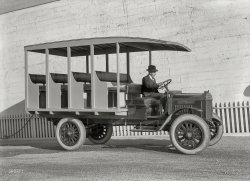
- Hudson Flivver School: 1930
- ... (?) titled The Telescope. 5x7 glass negative by Christopher Helin. View full size.
Galileo High School? Galileo High School's ... Posted by Dave - 02/07/2015 - 9:17pm -
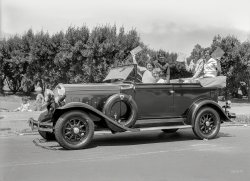
- Wayback Machine: 1929
- ... Golden Gate Park." Ready to rumble. 5x7 glass negative by Christopher Helin. View full size.
Wondering about rumble seats Was there an ... Posted by Dave - 04/30/2015 - 10:47am -
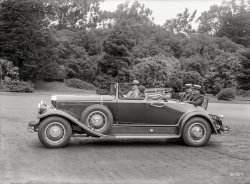
- Automobile Row: 1918
- ... showroom at the intersection. 5x7 inch glass negative by Christopher Helin. View full size.
Interesting photo. Anybody have any idea what ... Posted by Dave - 05/14/2016 - 12:52pm -
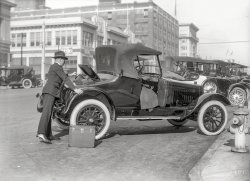
- Seven Speeds: 1921
- ... With a dynamo in tow. 6.5 x 8.5 inch glass negative by Christopher Helin. View full size.
6th and Townsend Holbrook, Merrill & ... Posted by Dave - 09/29/2014 - 7:42am -
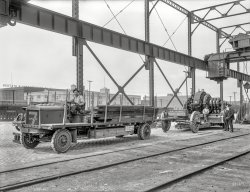
- V Is for Velie: 1916
- ... of Antiquated Automobiles. 5x7 glass negative by Christopher Helin. View full size.
Velie The Velie was made in my hometown of ... Posted by Dave - 03/05/2019 - 12:03pm -
![V Is for Velie: 1916 San Francisco circa 1916. "Velie Six touring car at Golden Gate Park." Filed under "V" in the Shorpy Abecedarium of Antiquated Automobiles. 5x7 glass negative by Christopher Helin. View full size.
VelieThe Velie was made in my hometown of Moline, Illinois, from 1908 to 1928. The car was named for Willard Velie, a grandson of John Deere.
Nothing runs like a DeereWillard Velie was the maternal grandson of John Deere. I wonder if the Velie Six came in green?
More on rear -- less on front.Rear wheels have 12 spokes, front 10 spokes -- interesting. Assume rear of car designed to support more weight despite engine in front.
[The reason is braking force. The front wheels don't have brakes. - Dave]
Abecedarium"Abecedarium." Wow, Dave, you are good!
And converselyAssuming it's a rear wheel drive, the need for stronger wheels to get the buggy moving.
Alpha BettyAbcde (pronounced Ab-si-dee) is a feminine name. Between 1990 and 2014, 328 girls in the U.S. were given the name Abcde.
Making me smartAbecedarium.
I love it when I have to look something up while browsing Shorpy. It's as if Shorpy were a mind-stretching vocabulary primer!
In AdditionVelie Motors also made a heck of a good airplane in the late 1920s, the Velie Monocoupe.
(The Gallery, Cars, Trucks, Buses, Chris Helin, San Francisco)](https://www.shorpy.com/files/images/SHORPY-1375.thumbnail.jpg)
- Leftward Ho: 1919
- ... the road with a variety of treads. 5x7 glass negative by Christopher Helin. View full size.
Hinged Note the "fat man's steering wheel," ... Posted by Dave - 10/02/2015 - 1:07pm -
![Leftward Ho: 1919 San Francisco, 1919. "Cadillac touring car at marina." Putting rubber to the road with a variety of treads. 5x7 glass negative by Christopher Helin. View full size.
HingedNote the "fat man's steering wheel," with hinged spoke, that could be swung out of the way for ease of entry.
HoldoverI don't know about the rest of the country, but in West Virginia we still had to know our hand signals to pass a driving test in 1975. Many motorcycles still didn't have turn signals and believe it or not, quite a few old cars and trucks were still around with only a single stoplight. Never had to turn my palm rearward for left or right turns. Came naturally for stops though.
Good Roads MovementAt first I thought that window sticker said "Yes Cool Roads" but then I realized it's Good Roads. Here's some info:
https://en.wikipedia.org/wiki/Good_Roads_Movement
Location clueOver on the left is the sign and tower of the Ghirardelli chocolate factory, so my guess is that we're probably on Bay St. and the empty block is an as yet undeveloped part of Fort Mason.
Hand Signals As the owner of a 1930 roadster lacking turn signals, I can attest to the reactions of modern drivers to hand signals such as that pictured here: they wave back.
Illegal Hand SignalWhere, in the South, I passed my driving test 67 years ago, one had to have the palm facing rearwards in hand signals. The palm was said to be lighter in color.
Scary StuffI used to ride motorcycles with no turn signals well into the 90's, it was always a little scary and iffy approaching turns and stops. People rarely knew about hand signals and what they meant, which made me extra cautious about turns and stops. It felt like I was riding with a big old target painted on my back.
It's Chestnut Street, not Bay Street.This would be Chestnut St, which is the original 1913 route of the Lincoln Highway It was the northernmost street in this area and had a streetcar line on it. The bare land was developed into the Marina District neighborhood, with Chestnut being the main commercial strip.
[Which would place the row of similar houses in the background on the 2900 block of Van Ness Ave., where at least one of them seems to remain. -tterrace]
Formerly the Fair?If this is Chestnut Street, would that bare land on the left have been the site of the 1915 Panama Pacific International Exposition?
[Yes; in this area specifically, "The Zone," the area of amusement concessions. -tterrace]
(The Gallery, Cars, Trucks, Buses, Chris Helin, San Francisco)](https://www.shorpy.com/files/images/SHORPY-711.thumbnail.jpg)
- And Step On It: 1917
- ... flowers in de vaz are fresh . 5x7 glass negative by Christopher Helin. View full size.
Handset pocket An early (short range, one ... Posted by Dave - 05/17/2016 - 8:27pm -
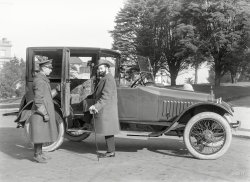
- Bicoastal Buick: 1929
- ... Oakland -- only Buick survives. 5x7 inch glass negative by Christopher Helin. View full size.
Timing It's a good thing they didn't try it ... Posted by Dave - 10/03/2014 - 12:50pm -
![Bicoastal Buick: 1929 A 1907 "Coast-to-Coast" Buick on San Francisco's Auto Row at Van Ness Avenue and California Street in 1929, evidently at the end of its jaunt. Of all the marques represented here -- Buick, Graham-Paige, Pontiac and Oakland -- only Buick survives. 5x7 inch glass negative by Christopher Helin. View full size.
TimingIt's a good thing they didn't try it the year before.
[In 1928? -tterrace]
No in 1906.
Long tripStarted in 1907, finished in 1929!
Still rolling alongNot part of your list but, there's another brand name here we all still see.
[Michelin! - Dave]
In the Words of the Old JokeIf you don't like the way I drive, keep off of the sidewalk.
22 Then and NowDriving a 22-year-old Brass Era automobile across the continent was a noteworthy feat in 1929. Not sure how much publicity one would get today, driving a 1992 Buick from New York to California.
Wouldn't you really rather have a Buick?The travelers are being greeted outside Howard Buick, with the greeter very likely being owner Charles S. Howard. Howard Buick was well known for promotional stunts like this.
C.S. Howard is probably better known as the owner of the celebrated racehorse Seabiscuit.
(The Gallery, Cars, Trucks, Buses, Chris Helin, San Francisco)](https://www.shorpy.com/files/images/SHORPY-141003-0002.thumbnail.jpg)
- Follow the Light: 1933
- ... the steering wheel. 5x7 inch dry plate glass negative by Christopher Helin. View full size.
Works like magic The headlight linkage ... Posted by Dave - 03/08/2016 - 2:06pm -
![Follow the Light: 1933 "Nash showroom, San Francisco, 1933." Where selling points include the Worm-Drive Axle and a center headlight that turns with the steering wheel. 5x7 inch dry plate glass negative by Christopher Helin. View full size.
Works like magicThe headlight linkage doesn't even connect to the steering linkage.
I'll give them benefit of the doubt and say they probably did that so customer could have a better demonstration of it in operation.
The missing linkWell the headlight is tuned the same direction as the wheels, but how?
The link doesn't seem to be connected to anything?
[Not at the moment. It's a setup like the one seen here a few weeks ago, on a 1931 Cadillac. Pivoting headlights and fog lamps had their moment as an aftermarket accessory in the 1920s and '30s. - Dave]
That center mounted headlightIn the 1960s, there was a Tucker Car on display at Sutro Baths in SF. They heavily pumped its "revolutionary" features, including a center-mount headlight that tracked as the steering wheel was turned.
Guess Tucker wasn't so original.
Citroen DSThe Citroen DS also has swivelling headlights. They were made from 1955 to 1975. Having driven one, I can assure you, at times, it was a very useful addition.
Not to be pushed?Did that worm drive rear axle make this Nash resistant to getting a push start if the battery was low? These were substantial, quality automobiles nevertheless.
Wow! That's a Doosey!Wow, nice lookin' car for a working man's price; my first thought when I looked at the photo was Duesenberg.
Terrific TileThe showroom floor is simply magnificent.
Citroen DS21I owned a '68 for a year or so in Tunisia. Not only did the headlights track with the steering wheel, but, as I recall, they also adjusted to passenger distribution by pitching lower when the rear end sank and the front end rose. Remarkable vehicle: superb technology, mediocre engineering, and horrible materials. Go like the devil, though.
(The Gallery, Cars, Trucks, Buses, Chris Helin, San Francisco)](https://www.shorpy.com/files/images/SHORPY-918.thumbnail.jpg)
- Blazing Buick: 1922
- ... If we ride along, can we ring the bell? 5x7 glassneg by Christopher Helin. View full size.
Factory equipment This model comes with a ... Posted by Dave - 09/25/2014 - 2:57pm -
![Blazing Buick: 1922 San Francisco, 1922. "Buick roadster at California Street firehouse." If we ride along, can we ring the bell? 5x7 glassneg by Christopher Helin. View full size.
Factory equipmentThis model comes with a door-dinger installed. Why wait for others when you can do it yourself?
World's RecordSmallest official Logo on any municipal vehicle, bar none.
From Charles Howard?Seabiscuit's owner began his rise to success in the aftermath of the 1906 San Francisco earthquake. His Buick dealership had some of the few functioning motor vehicles available after the quake, and he loaned them to the city. His generous action also made the public aware of the benefits of his motorcars. He further boosted sales by accepting horses as trade-ins. It's said that's where he learned to value, and eventually race them. Did the city government show its thanks by buying Buicks?
I Am RemindedIn British films of the '40s and '50s, police cars zoomed through the streets in pursuit of malefactors while clearing traffic from their paths by means of little bells that made my first tricycle's seem cacophonous by comparison.
Was the pursuit of justice ever really such a genteel affair?
San Francisco firefightersCould have spent a little less time polishing their pumpers and turned their attention to the door of the captain's Buick.
2150 California StreetIt looks like San Francisco still maintains a fire station at that address, but the original we only catch a glimpse of in this photo was amazing.
I'm actually eagerly hoping Shorpy has a better shot than the one I was able to find of the old building. (More photos here.)
It got uglyThe firehouse as it looks today at 2158 California Street.
Where'd he come from?I didn't even realize there was someone in the driver's seat until I noticed the hand on the steering wheel.
[He probably didn't see you, either. - Dave]
(The Gallery, Cars, Trucks, Buses, Chris Helin, San Francisco)](https://www.shorpy.com/files/images/SHORPY-GN-004A.thumbnail.jpg)
- Ready to Go: 1929
- ... is Graham, we'll leave up to you. 5x7 glass negative by Christopher Helin. View full size.
Looks brand new What a magnificent car. I ... Posted by Dave - 01/26/2016 - 2:04pm -
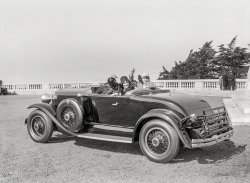
- Slippery Danger: 1924
- ... the front seat and the back. 5x7 inch glass negative by Christopher Helin. View full size.
Bearing Grease? Maybe not, 1924 specs ... Posted by Dave - 02/24/2015 - 11:20am -
![Slippery Danger: 1924 "Flint auto in San Francisco, 1924." With the Ghirardelli Square clock tower keeping time for whatever conversation is taking place between the front seat and the back. 5x7 inch glass negative by Christopher Helin. View full size.
Bearing Grease?Maybe not, 1924 specs hydraulic brakes front and rear-brake cylinders to activate the drum brakes. They were much less robust than the master cylinder was at pumping brake fluid. Older Chrysler products bear witness. Perhaps a drippy cylinder or seal?
Dicey in hilly SF.
Larkin StreetView Larger Map
We need more tractionSo why don't you sit in the back.
A striking carMy guess is that the car is a 1924 Flint. Flint was a part of Durant Motors, one of Billy Durant's failed enterprises after having been fired as CEO of General Motors three years earlier.
Looking at the marks on the inside of the right front tire, I'd say it's leaking grease from a bad wheel bearing seal.
Keep the Wyland Stanley photos coming - us gearheads out here love them.
Utility poll: Spikes or no spikes? When I was a kid utility poles had climbing spikes as does the pole in this picture's background. Until now I hadn't thought about how these climbing steps seem to be missing these days. With the advent of the bucket truck I reckon they've mostly gone way of the buggy whip.
Thanks Dave for the nice jolt to the memory.
$50 RewardCan anyone read the small print on the signpost regarding the reward? $50 was a large sum of money in 1924 - nearly $700 adjusted to today.
[Not pictured: smaller sign under this one labeled "$5 REWARD." - Dave]
Beautiful carI love the mounts for the headlights. Looks like something you would find on a ship's searchlight. While looking at this photo I am holding a badge like the one on the front of the radiator on the car. Beautifully crafted in nickel plating and blue enamel. Keep these old car pictures coming. I love them.
Pole SpikesThe climbing spikes still exist on some lines, but usually the two or three lowest are removable (these are carried by the lineman) to keep well-meaning but otherwise clueless kids (as I was back then) from climbing up and getting hurt.
Scene from BullittThe famous car chase went down this street.
(The Gallery, Cars, Trucks, Buses, Chris Helin, San Francisco)](https://www.shorpy.com/files/images/SHORPY-266-02.thumbnail.jpg)
- Dalmatian Wanted: 1920
- ... Fire Patrol truck." 5x7 inch glass negative by Christopher Helin. View full size.
oooooooo Tires Sporting the famous Octopus ... Posted by Dave - 05/02/2016 - 4:05pm -
![Dalmatian Wanted: 1920 San Francisco, 1920. "Underwriters Fire Patrol truck." 5x7 inch glass negative by Christopher Helin. View full size.
oooooooo TiresSporting the famous Octopus brand suction cup tread tires. A favorite among fire crews, for the invisible tire marks that did not need to be cleaned from the truck room floor.
Octopus treadsThe perfect size and age for your own antique fire engine. I love the octopus treads, something I have never seen on a tire before.
Underwriters Fire Patrol Company No. 1B?I think this is Underwriters Fire Patrol Company No. 1B at 147 Natoma St.
Today 147 Natoma is adorned with "Underwriters Fire Patrol" and "Headquarters". There are two bays but the front seems to have been remodeled.
The early American LaFrance trucks were chain driven. The chain gear was accommodated by the extra front flare on the rear fender. I have no idea what the extra rear flare was for.
A flare for economyTo John J's point, perhaps the rear fender flare lets you use the same stamping for either side of the truck - possibly important for a relatively low-production vehicle.
Been There, Done ThatFrom 1985 to 1987, I was a fire fighter at Homestead Air Force Base in Florida, which got wiped off the map by a hurricane shortly after I left. We actually had a Dalmatian which had the run of the station, as well as a nice "dog run" out back.
[Fun fact: The breed originated in Dalmatia, which is why they are called Dalmatians, not "Dalmations." - Dave]
Octo-TreadVacuum Cup Tires.
831 Buchanan Street at Birchwas the residence of Underwriter Fire Patrol Company 2 from 1918 to 1940. This would have been on the NW corner of the intersection with the building facing almost due east. This address fits the street corner at the left of the building, the lighting conditions and the street number of the building to the right ending in 41. At sometime both Birch and Buchanan streets have been interrupted and the area is now condos and parks.
(The Gallery, Cars, Trucks, Buses, Chris Helin, San Francisco)](https://www.shorpy.com/files/images/SHORPY-961.thumbnail.jpg)
- Road Locomotive: 1930
- ... the assembly line in 1929. 8x10 inch acetate negative by Christopher Helin, scanned by Shorpy. View full size.
Barn Find The latest craze ... Posted by Dave - 12/02/2014 - 2:39pm -
![Road Locomotive: 1930 San Francisco circa 1930s. "Locomobile 90 Victoria Sedan." With a factory price of $7300, this giant Series 90 Victoria came at the end of the road for the revered Locomobile brand, whose last cars rolled off the assembly line in 1929. 8x10 inch acetate negative by Christopher Helin, scanned by Shorpy. View full size.
Barn FindThe latest craze in the collector car world is barn finds. Don't even think about washing them! The more dust on them, the higher the price.
Looks like that's nothing new.
Giant IndeedI saw one at the Winter Park Concours a few years ago. It was the size of a large fire engine! The light blue car took the pre-war preservation class, first place. For those who do not know, all of the vehicle including the paint (but not the tires) must be original to enter this class! Truly an amazing sight.
WOW!$7,300 then is around $126,000 now.
CompartmentalizedI LOVE the door handles. What are the nifty little compartments/hatches underneath the doors?
[Jack. And maybe Jill. The kids have to ride somewwhere. - Dave]
Loco logoThe body maker's logo is on the belt molding in a tiny circle below the windshield post, but I can't read it.
[That might be the lucky owner's monogram. - Dave]
Peeking Through the Windows +80You might see this view now:
View Larger Map
My Grandfather's LocomobileMy grandfather, a physician in Revere, Mass., from the 1920s to the 1970s, had one of these. Not sure which model.
Two LocomobilesThe Locomobile is either a 1928 - 1929 model. The grille and radiator shape was different in 1927 and earlier model years. There are multiple reflections of other cars on the Locomobile body and windows. One of these makes it look like there is a tire in the back seat. According to the Locomobile Society website, only two of these later Model 90s are known to still exist.
A circa 1925 Locomobile is parked immediately outside the windows at the far left of the photo.
The Jackson Garage, seen across the street and listed in the 1929 San Francisco city directory, was located at 1641 Jackson. The name does not appear in the 1930 San Francisco city directly, but it does show a garage run by Albert Slotemaker at this address.
Depending on the manufacturer and the age of the car, the compartments below the doors were used for different purposes. Jacks and their accessories, tools, general storage,and even batteries were stored in these openings. Smaller doors or holes allowed owners and chauffeurs to grease the chassis or fill oil reservoirs/cups.
(The Gallery, Cars, Trucks, Buses, Chris Helin, San Francisco)](https://www.shorpy.com/files/images/SHORPY-153-01.thumbnail.jpg)
- Paiges on Parade: 1926
- ... a passel of parked Paiges. 8x10 film negative by Christopher Helin. View full size.
Counterbalanced Street Cars This stretch of ... Posted by Dave - 11/20/2014 - 4:44pm -
![Paiges on Parade: 1926 "Paiges on Fillmore Hill at Broadway." San Francisco in 1926 is the setting for this latest entry in the Shorpy Pageant of Extinct Conveyances, a passel of parked Paiges. 8x10 film negative by Christopher Helin. View full size.
Counterbalanced Street CarsThis stretch of Fillmore Street is so steep that, for many years, San Francisco's Market Street Railway employed counterbalance cars on its #22 line. These streetcars operated as normal electric cars for most of the line, but when they hit the Fillmore grade they hooked onto underground cables to help them up the hill.
But these weren't cable cars. Instead of a powered cables, like on the City's cable car lines, the counterbalance system required another car at the opposite end of the line to be simultaneously hooked onto the cable. Simply put, as one car descended the hill it helped another car ascend.
More info on the Fillmore Counterbalance here.
Traction for Horsepower?The Paiges drivers semm to have inconsiderately parked their vehicles fouling the cable car line.
But, I want to know what Shorpyists think is the purpose of the cleated roadway to the right of their vehicles.
[It's a sidewalk, a sort of road for pedestrians. The ribs are so you don't slip. On the other side of the street we have stairs. And overhead, power for the streetcars. -Dave]
Broadway at FillmoreExcept for the one peeking out from the left edge, all these buildings on Broadway are still there. The leftmost has had another floor added. The largest, 2275 Broadway, was built that year.
View Larger Map
Cable or Trolley?Here's a link to a description of the Fillmore St. counterbalance for electric trolley cars. The modern photo shows that the replacement trackless trolleys (trolley buses) detour around the hill.
88 years later: Then and NowI had to do some heavy perspective manipulation on this one, along with compositing another view to get the street somewhat in sync. The compositing is a bit crude, but I just wanted to give the impression of the street. I think it's reasonably effective, considering I can't get the same perspective from the other sidewalk that the original photographer got. (Google Streetview / September 2014.)
Click here for large size
Fillmore GripWasn't this the nickname for some sort of cable haulage for electric cars over a section of track that was too steep for normal traction?
Re: TractionJust a minor nitpick, but thne streetcars in San Francisco use underground cables for the motive power, not overhead lines. The cars clasp the underground cables and are towed up the hills and kept from speeding too fast back down.
The overhead lines are most likely power lines for homes and businesses.
[Wrong. See the next comment up. - Dave]
Time machine?Hey, why is there a closed circuit camera above the car second from the left! Time traveler shenanigans!
(The Gallery, Cars, Trucks, Buses, Chris Helin, San Francisco)](https://www.shorpy.com/files/images/SHORPY-134-02.thumbnail.jpg)
- Hudsons Bay: 1919
- ... for at least four furry friends. 5x7 glass negative by Christopher Helin. View full size.
License and Registrations Please The license ... Posted by Dave - 04/06/2016 - 7:41pm -
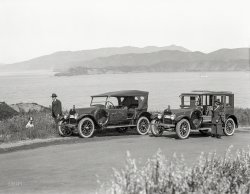
- Car Park: 1929
- ... telltale bollards standing guard. 5x7 glass negative by Christopher Helin. View full size.
Oh my Shoore is a pretty thang!
Back when ... Posted by Dave - 12/10/2016 - 12:02pm -
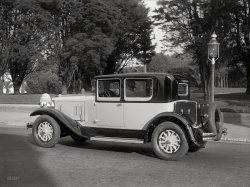
- Dort Sport: 1921
- ... Shorpy Exposition of Obscure Autos. 5x7 glass negative by Christopher Helin. View full size.
Spaghetti factory The Fontana Spaghetti ... Posted by Dave - 07/08/2016 - 10:15pm -
![Dort Sport: 1921 San Francisco. "Dort touring car, 1921." Latest display at the Shorpy Exposition of Obscure Autos. 5x7 glass negative by Christopher Helin. View full size.
Spaghetti factoryThe Fontana Spaghetti factory that is, back there at Van Ness Avenue and North Point. Now the spot's occupied by the notorious Fontana Towers, whose erection in 1962 spurred the drive for a height limit to protect waterfront views.
["Spaghetti factory," LOL. Everyone knows spaghetti is harvested! - Dave]
Curious times twoWhere are the bumpers?? And what are those two access doors used for on the lower side of the car? Grease fittings?
Leather interiorsThe leather interior looked so elegant, that I had to look for an interior picture.
This is a 1924 model, but looks very similar.
Cannon to the Left of ThemI can make out a shiny bronze cannon, seemingly aimed straight at her, just above the rearmost roof bow. The top word on the sign seems to read "Military". Would this be near an entrance to a military base?
[As a matter of fact, that's Fort Mason to the left - west - of the Spaghetti factory. -tterrace]
[That "shiny bronze cannon" is a brass standpipe; the sign says MILITARY RESERVATION. - Dave]
Talk about cost cutting.Maybe the "One hinge per door" policy led to the Dort's early demise.
Not So CheapThough it appears that there is just one hinge for each door, there were two. The visible lower hinge was angled slightly so that its pivot point passed through a point inside the door jamb where the upper, hidden hinge was located. It was an unusual, but not unheard of, trick in the early days. It also allowed the doors to swing in an upward path which made them self closing when you let go of them.
Height above ground lineThat just might be the door handle. Both doors front hinged and just pull on handle to open. If so, another reason why not successful.
[The Dort had rear-hinged doors, which opened from the front. Like the Dort, most open cars of the era had doors that unlatched from the inside and had no exterior handles. Closed cars had handles near the top of the door. - Dave]
Thanks to you both,
Ghost car?Is that a ghost car behind the Dort?
[A car in motion on the street behind. -tterrace]
(The Gallery, Cars, Trucks, Buses, Chris Helin, San Francisco)](https://www.shorpy.com/files/images/SHORPY-1003.thumbnail.jpg)























